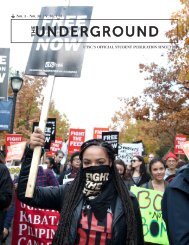You also want an ePaper? Increase the reach of your titles
YUMPU automatically turns print PDFs into web optimized ePapers that Google loves.
SCIENCE & TECH<br />
31<br />
EXPLORING THE ROUGE<br />
Kristina Dukoski,<br />
Science & Tech Editor<br />
Canada is home to many amazing<br />
natural sites, but not all of them are accessible.<br />
In fact, if you live in an urban area, chances<br />
are you have to designate time to unwind<br />
and immerse yourself in the scenery. Well, we<br />
city-slickers need not worry, because there’s<br />
a beautiful landmark right in our backyard:<br />
Rouge Valley.<br />
According to Parks Canada, “Once<br />
fully established, Rouge National Urban Park<br />
will be one of the largest and best protected<br />
urban parks of its kind in the world, spanning<br />
79.1 square kilometres in the heart of Canada’s<br />
largest and most diverse metropolitan<br />
area.” Perhaps a map could come in handy<br />
when you choose to explore the largest park<br />
in the world, but it does not end there: “Rouge<br />
National Urban Park is comprised of a rich<br />
assembly of natural, cultural and agricultural<br />
landscapes with many remarkable features,<br />
including: amazing biodiversity with over<br />
1,700 species of plants and animals.” The<br />
best part is that there will soon be an app for<br />
that.<br />
Alex Cavanagh, Derek Etherton,<br />
Kaitlyn Chow, and Winston Lee, four UTSC<br />
students, are working to give life to an app<br />
that will allow Rouge Valley visitors to inform<br />
themselves of the flourishing vegetation and<br />
wildlife the park has to offer. Many may wonder<br />
why an app is necessary for a day outdoors,<br />
but upon being given some information<br />
about Canada’s largest urban park, it all<br />
begins to make sense.<br />
Derek Etherton is in his fourth year<br />
of study, in a computer science program. The<br />
project fulfills his third research work-term, as<br />
an eight-month contract software developer.<br />
Etherton explains how he happened upon the<br />
path that led him to his program. “It started<br />
pretty early for me. I got into video games,<br />
which somehow led me to video game development.<br />
I took computer science in high<br />
school, and here I am,” he says. He then<br />
talked about his experience with the co-op<br />
aspect of the program. “Co-op for computer<br />
science is super streamlined, I think for management<br />
as well. Maybe all undergrad programs.<br />
You’re in the program, so they send<br />
you an email saying, ‘Hey, it’s time to start applying<br />
for jobs!’ Then, a bunch of job postings<br />
go exclusively to your U of T inbox. You tailor<br />
your resume and cover letter, hit the ‘apply’<br />
button, then you’re set.”<br />
Like Etherton, Alex Cavanagh is<br />
also in his fourth year of study in a co-op<br />
computer-science program, fulfilling his third<br />
research work-term as a software developer<br />
of the app. “I love technology and video<br />
games. I loved interacting with technology as<br />
a kid, so I took it in high school; I loved it. The<br />
one thing that drew me here was the co-op<br />
program. So, I looked at that, and thought,<br />
‘Hey, if I could work while I go to school, and<br />
take summers doing what I love to do, then<br />
why not?” Cavanagh shares. Regarding the<br />
specifics of the Rouge project, Cavanagh details<br />
how the team works. “Derek and I are<br />
the software developers, whereas Winston<br />
and Kaitlyn are the content half. We’re building<br />
this mobile application for the Rouge. It’s<br />
basically an info-guide. So, if it’s your first<br />
time there, you can open it up, and see geographically<br />
on a map what’s around you,” he<br />
says. “You can see some awesome pictures<br />
and ‘favourite’ some spots so you can plan<br />
your next trip.”<br />
Winston Lee is currently enrolled<br />
in the one year-long Master of Environmental<br />
Science program, and The Rouge project<br />
will fulfill a research internship. “I like environmental<br />
science a lot, especially in terms of<br />
the college-y aspect. I like looking at a largescale<br />
natural system in terms of how different<br />
species are important components to the system…This<br />
one-year program offered a co-op<br />
internship opportunity, so that really caught<br />
my interest,” says Lee on how he got involved<br />
in the project. Lee believes that the co-op program<br />
could help students who are looking to<br />
prepare for the future. “Once you get out of<br />
undergrad, you think, ‘Oh, what do I do now?’<br />
This seemed like a good way to get my foot in<br />
the door in terms of finding a full-time job.”<br />
The fourth member of the team, Kaitlyn<br />
Chow, is enrolled in the same program as<br />
Lee. She is also fulfilling a research internship<br />
with the app development. “I’ve always been<br />
interested in environmental issues on a personal<br />
level, but I never thought that it would<br />
be my career path,” Chow explains. “I actually<br />
did my undergrad in microbiology…Eventually,<br />
I figured out that wasn’t what I really wanted<br />
to do, so after undergrad, I took a year off<br />
to figure out where I wanted to go from there.<br />
I discovered the program here at UTSC, and I<br />
found out that they offered internship components;<br />
so, it seemed like a really good way to<br />
get some practical experience.” Taking on the<br />
content aspect, she and Lee play an important<br />
role in the app’s development. “Winston<br />
and I are both content curators of the project.<br />
So, we put together all of the writing and the<br />
images for the app,” she explains. “We want<br />
the app to be something that a first-time visitor<br />
can take to the park and learn about what<br />
Rouge [Valley] has to offer, but we also want<br />
it to be detailed enough that someone who<br />
has been to the park many times can still find<br />
interesting and useful information in there.”<br />
So, how did this project come to be?<br />
Parks Canada has had a long-standing partnership<br />
with UTSC, and specifically The Hub,<br />
which is under the Office of Research. Maintained<br />
by VP Bernie Kraatz and Director Gray<br />
Graffam -- also the Senior Fellow & Faculty of<br />
Arts, Culture & Media -- The Hub is the center<br />
where innovation and business interplay.<br />
Through the partnership with Parks, Graffam<br />
got in contact with Omar Mcdadi, External<br />
Relations Manager III for Parks Canada,<br />
and began discussing the possibilities, and<br />
an idea was born. Through the Arts and Sciences<br />
Co-op under Dean/ VP Academic Bill<br />
Gough, Cavanagh, Etherton, Chow, and Lee<br />
were selected through a standard application<br />
and interview process to begin development<br />
on the app. With the help of IITS (Information<br />
and Instructional Technology Services) and<br />
BOSA (Business, Operations and Strategic<br />
Affairs), the idea is becoming a reality.<br />
www. the-underground.ca JANUARY AUGUST 22 7 -- FEBRUARY OCTOBER 5, 3, 2016<br />
VOLUME 35, 36, ISSUE 05 01


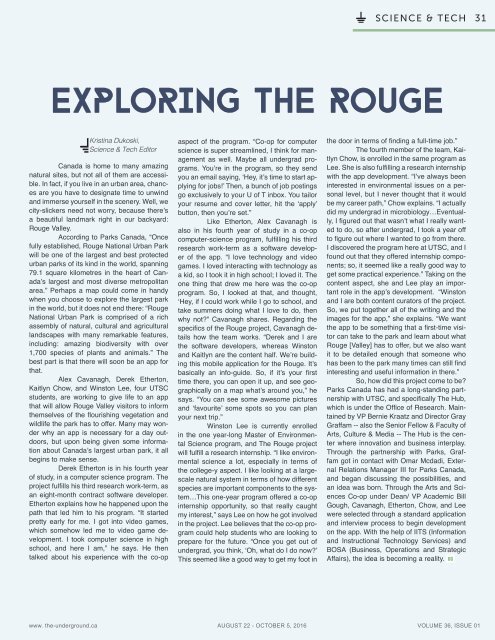


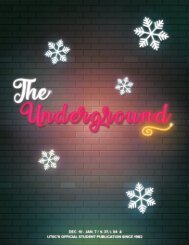
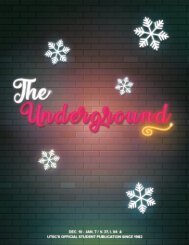
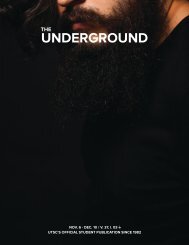
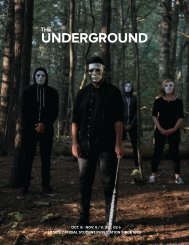

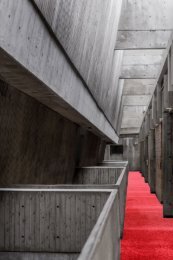

![[WEB]_ISSUE 06[EDIT3]_RachelChin](https://img.yumpu.com/58105406/1/190x245/web-issue-06edit3-rachelchin.jpg?quality=85)
